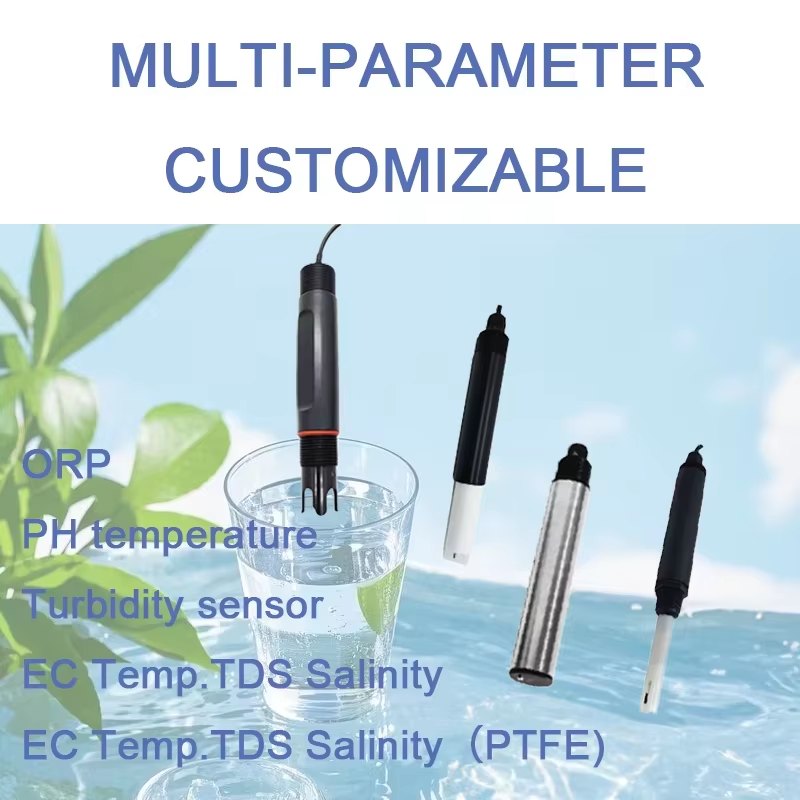Summary: In the wave of transformation from traditional to precision and smart agriculture, water quality pH sensors are evolving from unfamiliar laboratory instruments into the “intelligent taste buds” of the field. By monitoring the pH of irrigation water in real-time, they safeguard crop growth and have become a key component in scientific water and fertilizer management.
I. Case Background: The Predicament of “Tomato Valley”
At the “Green Source” modern agricultural demonstration base in Eastern China, there was a 500-acre modern glass greenhouse dedicated to growing high-quality cherry tomatoes, known as “Tomato Valley.” The farm manager, Mr. Wang, was consistently troubled by a problem: uneven crop growth, with leaf yellowing and stunted growth in some areas, coupled with low fertilizer efficiency.
After preliminary investigation, pests, diseases, and nutrient deficiencies were ruled out. The focus eventually shifted to the irrigation water. The water source came from a nearby river and collected rainwater, and its pH value fluctuated due to weather and environmental changes. They suspected that unstable water pH was affecting fertilizer availability, leading to the observed problems.
II. The Solution: Deploying an Intelligent pH Monitoring System
To solve this problem definitively, the “Green Source” base introduced and deployed an intelligent irrigation water monitoring system based on online water quality pH sensors.
- System Composition:
- Online pH Sensors: Installed directly on the main irrigation water intake pipe and at the outlet of the fertilizer mixing tank in each greenhouse. These sensors operate on the electrode method principle, enabling continuous, real-time detection of water pH.
- Data Acquisition and Transmission Module: Converts the analog signals from the sensors into digital signals and transmits them wirelessly to a central control platform via Internet of Things (IoT) technology.
- Smart Central Control Platform: A cloud-based software system responsible for receiving, storing, displaying, and analyzing pH data, and for setting management thresholds.
- Automatic Adjustment System (Optional): Linked to the platform, it automatically controls the injection of small amounts of acid (e.g., phosphoric acid) or alkali (e.g., potassium hydroxide) solution to precisely adjust the pH when values go out of range.
- Workflow:
- Real-time Monitoring: The pH of the irrigation water is captured in real-time by the sensors before it enters the drip irrigation system.
- Threshold Alarms: The optimal pH range for cherry tomato growth (5.5-6.5) is set in the central control platform. If the pH drops below 5.5 or rises above 6.5, the system immediately sends an alert to managers via a mobile app or computer.
- Data Analysis: The platform generates pH trend charts, helping managers analyze patterns and causes of pH fluctuations.
- Automatic/Manual Adjustment: The system can be set to fully automatic mode, adding acid or alkali to precisely adjust the pH to the target value (e.g., 6.0). Alternatively, managers can manually activate the adjustment system remotely upon receiving an alert.
III. Application Results and Value
After three months of using the system, the “Green Source” base achieved significant economic and ecological benefits:
- Improved Fertilizer Efficiency, Reduced Costs:
- Most nutrients (like nitrogen, phosphorus, potassium) are most readily available to plants in a slightly acidic environment (pH 5.5-6.5). By precisely controlling pH, fertilizer use efficiency increased by approximately 15%, reducing fertilizer usage by about 10% while maintaining yield.
- Improved Crop Health, Enhanced Quality and Yield:
- Resolved issues like “nutrient deficiency chlorosis” (yellowing leaves), which occurred because high pH locked up micronutrients like iron and manganese, making them unavailable to plants. Crop growth became uniform, and leaves turned a healthy green.
- The Brix level, taste, and consistency of the cherry tomatoes improved significantly. The marketable fruit rate increased by 8%, directly boosting economic returns.
- Enabled Precision Management, Saved Labor:
- Replaced the outdated method of requiring frequent manual sampling and testing with pH test strips or portable meters. Enabled 24/7 unattended monitoring, significantly saving labor and eliminating human error.
- Managers can check the water quality status of the entire irrigation system anytime, anywhere via their phones, drastically improving management efficiency.
- Prevented System Clogging, Reduced Maintenance Costs:
- Excessively high pH can cause calcium and magnesium ions in the water to precipitate, forming scale that clogs delicate drip emitters. Maintaining the proper pH effectively slowed scale formation, extended the drip irrigation system’s lifespan, and reduced maintenance frequency and costs.
IV. Future Outlook
The application of water pH sensors extends far beyond this. In the blueprint for future smart agriculture, it will play an even more central role:
- Deep Integration with Fertigation Systems: pH sensors will combine with EC (Electrical Conductivity) sensors and various ion-selective electrodes (e.g., for nitrate, potassium) to form a complete “nutritional diagnosis system” for on-demand fertilization and precision irrigation.
- AI-powered Predictive Control: By analyzing historical pH data, weather data, and crop growth models with AI algorithms, the system can predict pH trends and intervene proactively, moving from “real-time control” to “predictive regulation.”
- Expansion to Aquaculture and Soil Monitoring: The same technology can be applied to manage water quality in aquaculture ponds and used as probes for in-situ soil pH monitoring, creating a comprehensive agricultural environmental monitoring network.
Conclusion:
The case of the “Green Source” base vividly demonstrates that the humble water pH sensor is a bridge connecting water resource management and crop nutritional health. By providing continuous, accurate data, it pushes traditional “experience-based agriculture” toward “data-driven smart agriculture,” offering solid technical support for achieving water conservation, fertilizer reduction, quality improvement, efficiency enhancement, and sustainable agricultural development.
We can also provide a variety of solutions for
1. Handheld meter for multi-parameter water quality
2. Floating Buoy system for multi-parameter water quality
3. Automatic cleaning brush for multi-parameter water sensor
4. Complete set of servers and software wireless module, supports RS485 GPRS /4g/WIFI/LORA/LORAWAN
For more water sensor information,
please contact Honde Technology Co., LTD.
Email: info@hondetech.com
Company website: www.hondetechco.com
Tel: +86-15210548582
Post time: Oct-22-2025


